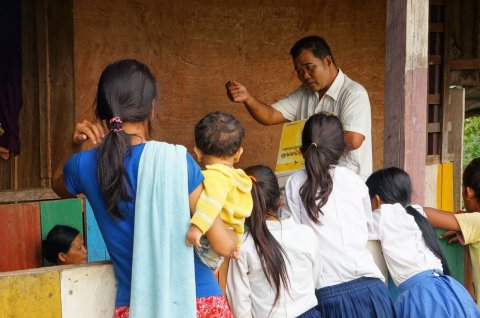Time to optimise the radical cure of malaria
Quick Summary
- We’ve made excellent progress fighting malaria, but more effort is needed to fight Plasmodium vivax, a debilitating and potentially deadly form of malaria
- P. vivax is a deceptive parasite that can hide in the liver and come back, again and again
- Young children are most at risk since they get repeated bouts of malaria, becoming more anaemic and vulnerable to other infections
- We need better radical treatment of all stages of infection, to prevent recurrence and spread to other people in the community
What is Plasmodium Vivax malaria?

We’ve made great progress fighting one of the world’s deadliest parasitic infections, Plasmodium falciparum malaria, but we still have more a lot more work to do to tackle P. vivax malaria, the most widespread species.
Outside of Africa, P. vivax is the predominant cause of malaria, resulting in approximately 15 million cases each year, with an estimated global financial burden of US$240-420 million.
Unlike other forms of malaria, P. vivax can lie dormant in the liver only to attack again weeks or months after the first illness, without the patient being bitten again by another mosquito.
Young children are the worst affected by recurrent episodes of P. vivax malaria. They suffer from debilitating illness and severe anaemia, and even death.
Radical cure
To cure a patient of P. vivax malaria, radical treatment is needed to target both the blood stage parasites (which cause illness) and the liver stages (which cause relapsing infection).
The most common treatment for the blood stages is chloroquine, a drug that has been used widely for more than 60 years.
To prevent the dormant liver stages relapsing, patients must also be treated with primaquine, the only available drug that can kill them.
Some medicines can cause anaemia
While most doctors prescribe chloroquine to cure the acute symptoms, they are often reluctant to prescribe primaquine since it can cause anaemia in patients with a deficiency in an inherited enzyme known as G6PD, present in 5 to 30% of individuals living in malaria endemic areas.
As such, the World Health Organization recommends that primaquine is taken over 14 days to reduce the risk of anaemia occurring.
Large-scale IPD analysis
To investigate the potential for using radical cure strategies, combining chloroquine and primaquine, the WorldWide Antimalarial Resistance Network (WWARN), led by our Clinical Group based at The Menzies School of Health Research, collaborated with more than 50 research institutions to share and analyse data from 37 antimalarial clinical trials from across 17 different countries.
The team gathered data from over 5,000 patients – a large enough sample size to enable us to explore the effect of chloroquine dosing and the benefits of adding primaquine to reduce recurring infections within six weeks.
We found that over a third of patients received a lower than recommended dose of chloroquine (less than 25 mg/kg based on WHO guidelines). Increasing the dose of chloroquine to 30mg/kg reduced the chance of malaria returning, especially in children under 5 years old.
Reducing the risk of recurrent malaria
However, the best results were observed in patients who also received primaquine. In these patients the risk of recurrent malaria fell by a staggering 90%.
These findings highlight the importance of implementing radical dual-action treatment to ensure a long-lasting cure for patients with P. vivax malaria.
Preventing recurrent infections will reduce the risk of other complications such as anaemia and slow the spread of malaria from infected patients to the wider community.
Despite the obvious public health benefits of radical cure, several challenges remain if we are to ensure that revised treatment approaches can be rolled out in a safe and effective manner.
Ideally, patients should be tested for G6PD deficiency prior to prescribing primaquine, however, tests are rarely available in remote healthcare settings where patients are commonly treated. In addition, if primaquine is prescribed patients often do not complete the whole 14-day course, and this results in higher rates of treatment failure.
Patient adherence is a challenge
While public health campaigns could potentially improve patient adherence, alternative treatment options such as shorter course high dose primaquine are also being explored.
Tafenoquine, a new drug, has recently been approved by the USA drug regulatory authorities.
It can be taken as a single dose medicine, and is the first new antirelapse drug to be brought to market for more than 60 years.
Despite this exciting news, tafenoquine’s long-lasting properties raise some concerns. Like other antimalarials, it can cause destruction of red blood cells in individuals with G6PD deficiency.
New diagnostic tools are needed
As such, new diagnostic tools are being developed to support routine G6PD screening for all patients.
The ability to provide safe and effective radical cure for P. vivax will require optimal use of the treatments, including the correct dose and best combination of existing and newly available medicines.
If these drug combinations can be used effectively we will be much better equipped to combat one of the most widespread forms of malaria, and ultimately deliver the global effort to eliminate malaria from all affected countries.